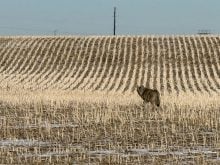SASKATOON — It’s a sure bet Western Canadian farmers will plant more canola this year.
The question is, how much more? Farmers confounded analysts, insiders and even Statistics Canada last year by planting 10.3 million acres of canola. That eclipsed the previous record acreage of 9.1 million.
“Last year all of us analysts were totally wrong,” said Larry Ruud, grains market analyst with Alberta Agriculture. “I failed to find anyone that was looking for 10.3 million acres.”
Most were expecting between 8.5 and 9.5 million acres, he said, because in 1992 farmers seeded 7.5 million acres: “We thought, my god, this is a huge increase.” Canola acreage over the past 10 years has averaged 6.5 million acres.
Read Also

Agritechnica Day 2: The future of tractor power, building quicker crop apps and large farms and tech
Agritechnica Day 2: The future of tractor power, building quicker crop apps with Syngenta and large farms and tech
This year, with farmgate prices for new-crop canola still at $7 per bushel in mid-winter, most are pointing to price as the reason canola acreage is going to take another quantum leap.
Not everyone is in agreement, however, on how big that increase is going to be.
Ruud in Alberta is the most bullish of the analysts polled.
“To me, I wouldn’t be surprised if we hit 13 million acres,” he said. “Here in Alberta alone, there’s potential for us to add a million acres.”
Ruud says farmers throughout the dark brown soil zone who tried canola last year and met with success are going to increase their individual acreage.
“Guys that grew 100 or 200 acres last year are looking to double or even triple their acreage this year. That’s not uncommon. And it can potentially add up to 600,000 to a million acres in Alberta.”
More than 12 million acres
Nick Underwood, crop production co-ordinator with the Canola Council of Canada, doesn’t believe acreage will get to 13 million. But he does think it will be more than 12 million.
Farmers are frustrated with growing wheat, he said.
“Why would you grow cereals for $2 a bu. when you can lock in a price of at least $6-7 a bu. on canola? It’s that simple.”
Underwood is expecting the new interest in the crop to continue from the southern Prairies which is outside the traditional canola belt.
“We’re already maxed out in the traditional areas,” he said.
Not only is he expecting to see the crop in the brown and dark brown soil zones in Saskatchewan but also, like Ruud, he expects it should make a big move into southern Alberta.
Try Polish varieties
Underwood has some advice for first- or second-try growers in the southern Prairies: Looking seriously at the Polish varieties of canola, he says, which mature earlier. And get them in early, as soon as late April.
Errol Anderson, manager of Palliser Grain in Calgary, is also looking for big canola acreage this year, and says the 12-13 million mark is attainable.
The limiting factors
Limiting factors are whether farmers will be able to fit another canola crop into their crop rotations and the availability of good seed.
Anderson also thinks that better wheat prices, especially durum, may entice growers to stay with something they know is a sure thing, rather than risk big acreage on canola.
And even though acreage has the potential to climb by 25 percent, Anderson isn’t expecting “trend’ yields — which were nearly 23 bu. to the acre — on all that acreage. He’s expecting yields on some of the more marginal land to range between 15-18 bu. to the acre.
Greg Kostal, senior grains analyst with the UGG’s Grower Marketing Services in Winnipeg thinks that 1994 is going to be a bench mark year as far as canola goes.
“We’re going to see how far farmers are willing to push their rotations this year,” he said. “We’re going to find out the maximum level of canola this year.”
With that push, he’s expecting some agronomic problems to show up. Sclerotinia stem rot, for one, and blackleg, for another. In subsequent years, he expects acreage will fall back.
In the meantime, however, Kostal said “we’re still talking big acreage.” He, too, thinks 12 million is reachable.
Kostal estimates Saskatchewan alone can pull another million acres into canola: “A million acres compared to the total acreage base in Saskatchewan is peanuts.”
As far as price goes, Kostal says odds favor $7 canola once every four years, and points out farmers have the ability to forward sell the new crop at close to that price right now.
“Locking in a profit is never a bad idea.”














